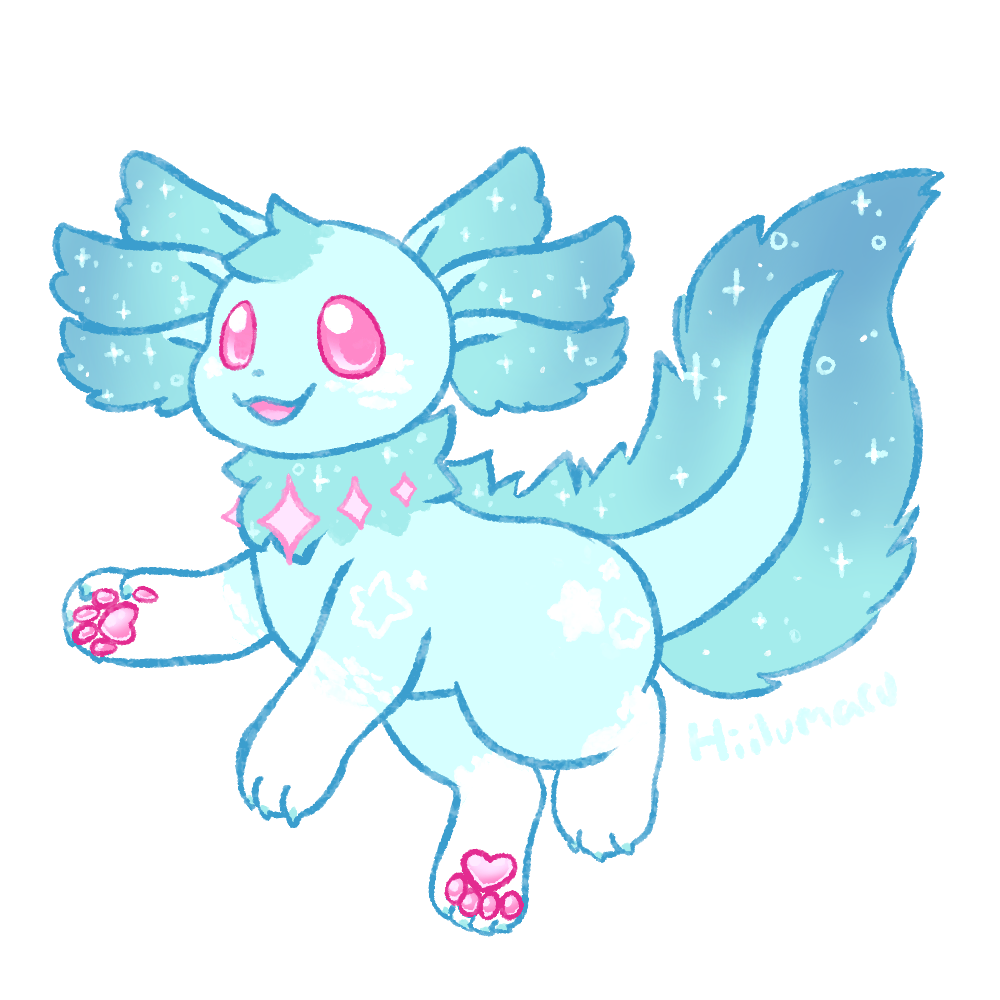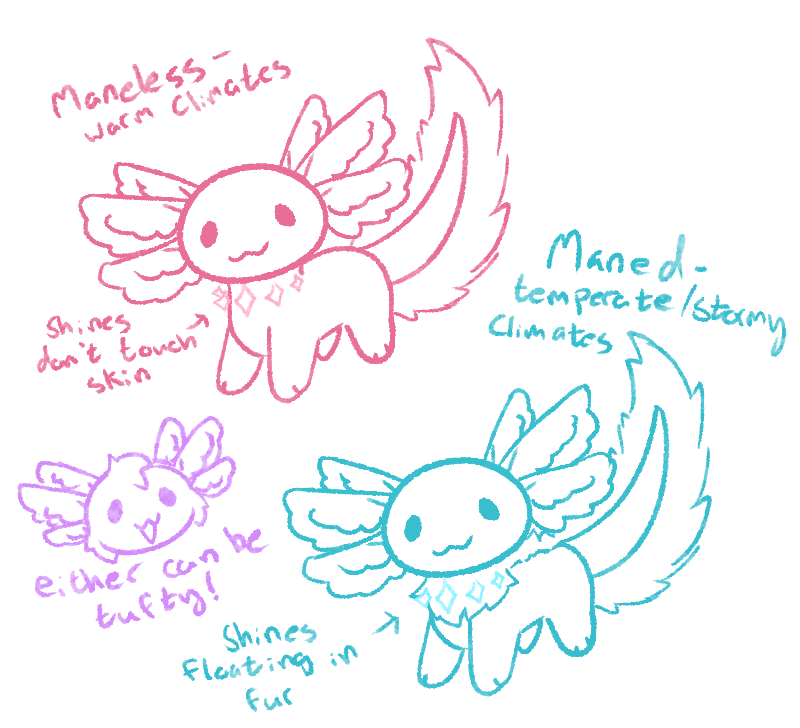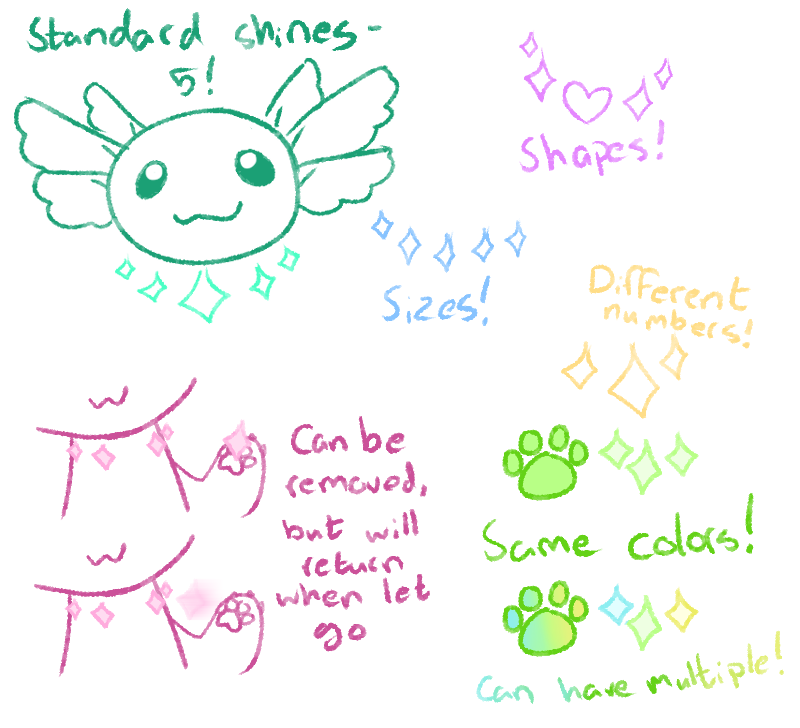Astrolotls
Open species | anthro or feral
Below is info about feral Astrolotls!

Astrolotls are a species of neotenous dragon that remain in a nymph form for their entire adult lives, keeping a small size and living among the nooks and crannies of the clouds.
Basics
Lifespan: up to 5000 years
Diet: meat, magic
Living group size: small
Habitat: Cumulus cloud terrain, high-elevation forests and mountains, occasionally underwater
Breeding rate: one clutch every 200-350 years
Anatomy

Astrolotls are roughly the size of a medium dog, but can vary in size from 30 to 80 pounds. They have a similar appearance to their terrestrial counterparts, but unlike an axolotl, they have thick, strong legs for traversing the clouds when flying isn't necessary.
Their bodies are covered in thick protective fur. Though their tails and frills look like those of an axolotl, they function differently - the thick ridge of fur on the tail is their main means of propulsion when flying, but they also cover themselves when sleeping to camouflage themselves. Their frills, however, serve more of a purpose. Not only do they aid in the astrolotl's notorious flight agility, but they act as a sensory organ for detecting chemical changes and currents in the air, acting as antennae. six frills is most common, but they can range from four to eight; the more frills they have, the better their steering. Depending on the climate, astrolotls may or may not have a mane and back ridge, and they'll grow or shed theirs if they spend long enough in a climate other than what they're used to.
Shines

Around their necks, Astrolotls have sparkles of light that form from magic use, which match the color of their paws. The shines themselves are purely magic, and are believed to store excess magic power for other purposes - most of their magic, however, is stored in their paw pads, and used to levitate. While the shines aren't usually very useful on their own, the center shine is capable of concentrating magic power to be used for attacks, like beams or electrical magic, when threatened. The shines are usually the same four-pointed star shape, however, they can come in other shapes and quanitites, varying fron individual to individual.
Coat

Astrolotls can have fur in any variety of colors, frequently bearing patterns that help them blend into the sky, such as stars or glowing markings or cloudlike patterns, but there isn't really any limitation. Their main coat colors don't change, but the color of their frills, tail and mane will adjust to either their surroundings or the sky itself for camouflage. They can control the color of their frills, but it also happens unconsciously unless they make an effort to keep them one specific color.
Diet
Astrolotls usually live in the sky, hunting birds and other skyfaring creatures, and they're primarily carnivores. However, they will not only supplement their diet with skyfaring plants, but will also eat solid magic as well if they can find it. It's not uncommon for astrolotls to live either on the surface land or even underwater, as they're just as capable in either habitat, and will adapt their diet to wherever they're living; some will opt to survive on magic alone, or none at all, and any astrolotl will hunt for fish before any land animals, due to how easily they adapt to swimming. While they aren't the most competent at fighting compared to other, larger creatures of the sky, they still have claws and fairly sharp teeth, and will often use magic to take down prey.
Social behavior
As astrolotls are fairly vulnerable in their own habitat, they tend to live together in small groups where they can overcome larger threats by number. They are intelligent enough to be able to speak and adorn themselves, though their chosen range of accessories are fairly limited - anything clipped into their frills will just be torn off by the wind, so most accessories are either fastened directly to the tail and frill bases, or firmly attached to their body. While they tend to be wary of things larger than them, they're quick to determine if something is a threat, and are generally very welcoming of anything that isn't trying to eat them.
"Adult" astrolotls

Like real axolotls, astrolotls are a permanently neotenous type of a species that otherwise matures to its final stage of adulthood naturally. In rare lab cases, it's been proven possible to make an axolotl grow into the normal adult salamander that they otherwise never become, and astrolotls are the same way - like axolotls, though, they live a very limited life in this form. An astrolotl may mature into a normal furred dragon under specific circumstances; subjecting them to magic too powerful for their bodies, or them having to spend a long time in severe magical storms will force them to grow. However, these "adult" astrolotls lose their ability to levitate entirely, instead having to rely on wings to fly, and lose a lot of their agility without much of a gain in size to make up for it, usually leaving them more vulnerable than they were before. They also lose the ability to breed, even with other grown astrolotls, and have a notably shorter lifespan - no more than 1000 years from when they changed, though usually a fair bit less. Astrolotls will naturally avoid situations that would cause this, as any situation that would influence them to grow is already potentially lethal regardless, so it's very rare to see an adult-stage astrolotl - it's often a sign of some recent magical catastrophe when one is spotted.
 Species
Species